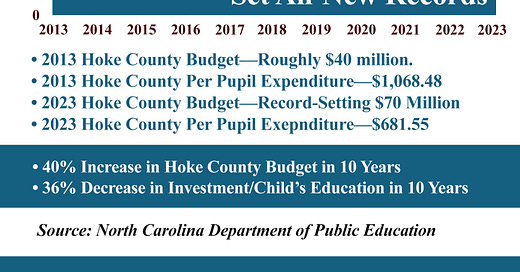Hoke County Investment in Students Lowest in Decades—Down From $1,273.40 in 2008
Per pupil expenditure during the 2023 school year—according to North Carolina—was $681.55, significantly under 2008’s figure of $1,273.40. Meanwhile, the county budget has shattered records.
Public information posted online by the North Carolina Department of Public Instruction indicates the Hoke County Commission made a $681.55 per pupil expenditure (PPE) from its annual budget for the 2022/2023 school year. In 2008, however, the number reported by the same government office was an enviable $1,273.40.
Meanwhile, the county’s tax revenue and spending have skyrocketed. In 2023, according to The News-Journal, Hoke County shattered all previous records with a budget of $70 million. That highwater mark didn’t last long, though. It’s up to $75 million this year.
Hoke County’s budget in 2008 came in at a lowly $32.7 million—less than half. Yet the same year the commission somehow managed to invest $1,273.40 in each child’s education.
With spending more than doubled from 2008 to 2023, and PPE cut nearly in half, a growing number of residents wonder where the money is really going. Adjusted for inflation—for a more accurate apples-to-apples comparison—the decline in the school system’s purchasing power is more dramatic.
Adjusted for Inflation
The U.S. Bureau of Labor Statistics inflation calculator indicates Hoke County’s $70 million budget in 2023 carried the same purchasing power as $49,950,000 did in 2008. Last year’s commission approval of $681.55 PPE, converted to 2008 value, is $486.34.
The figures indicate Hoke County’s 2023 budget was capable of buying $17 million more in than it could in 2008. Yet, the investment in each child’s education in 2023 carried $800 less purchasing power than what the school system received 16 years before. That’s a 62-percent decline.
Long-Term Result?
There’s no consensus in local opinion as to the catalysts fueling the dramatic decline, but experts nationwide agree on the results when education funding is a low-to-no priority for local government.
Decreased pay—According to the Public Policy Institute of California, “…a 10 percent increase in school spending for 12 years led to 7.7 percent higher wages and a 9.8 percent increase in family income when students reached adulthood. Higher spending also led to higher rates of high school graduation, more years of completed education, and lower incidence of adult poverty.”
Increased Arrests—A University of Michigan article in 2022 cites a study that found, “Students who attended better-funded schools were 15% less likely to be arrested through age 30.”
Business Climate Decline—“Communities that offer safe, healthy schools attract more qualified workers and create a larger consumer base for local businesses. In addition, when schools need infrastructure upgrades and repairs, and bond measures are approved, the job creation can fuel areas of construction, IT and other related fields,” according to Forbes magazine.
Locally—According to one teacher, Hoke County High School has become an underground fight club and the children’s education is suffering.
Hoke County PPE Spending Each Year
(Figures from the North Carolina Department of Public Instruction and adjusted by the U.S. Bureau of Labor Statistics inflation calculator—August 2024 and August 2008 values, respectively)
Year Amount Inflation adjusted to 2008 buying power
2023 $ 681.55 $ 486.34
2022 $ 740.84 $ 548,02
2021 $ 981.58 $ 800.54
2020 $ 999.61 $ 848.93
2019 $ 916.74 $ 782.84
2018 $ 997.47 $ 866.69
2017 $ 906.20 $ 808.64
2016 $1,062.51 $ 966.50
2015 $1,052.12 $ 967.52
2014 $1,040.10 $ 958.04
2013 $1,073.17 $1,005.30
2012 $ 906.55 $ 862.11
2011 $ 980.10 $ 947.83
2010 $1,087.97 $1,091.83
2009 $1,249.90 $1,268.73
2008 $1,273.40 $1,273.40




